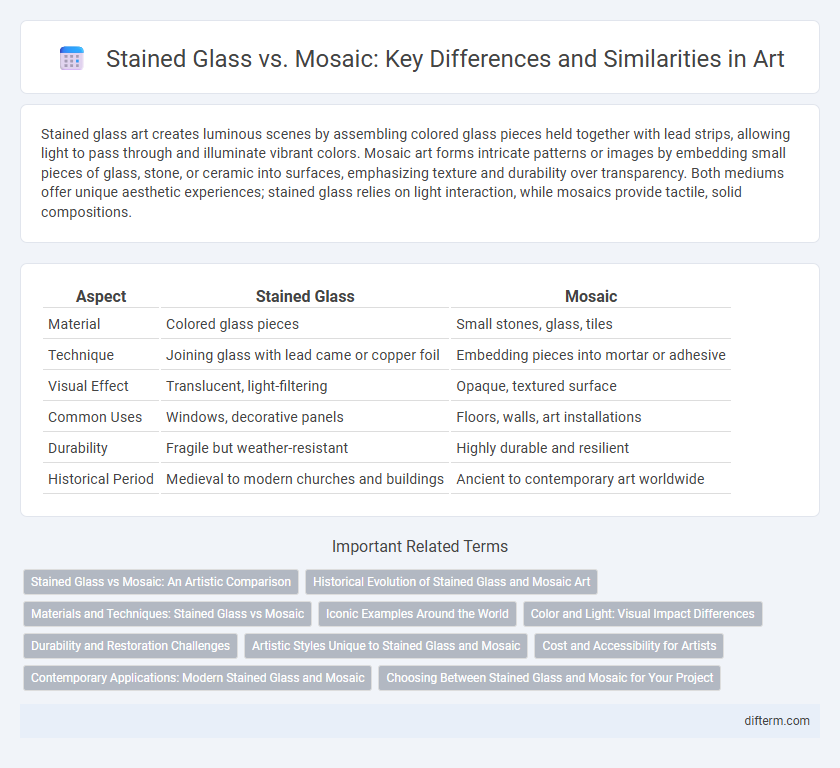Stained glass art creates luminous scenes by assembling colored glass pieces held together with lead strips, allowing light to pass through and illuminate vibrant colors. Mosaic art forms intricate patterns or images by embedding small pieces of glass, stone, or ceramic into surfaces, emphasizing texture and durability over transparency. Both mediums offer unique aesthetic experiences; stained glass relies on light interaction, while mosaics provide tactile, solid compositions.
Table of Comparison
| Aspect | Stained Glass | Mosaic |
|---|---|---|
| Material | Colored glass pieces | Small stones, glass, tiles |
| Technique | Joining glass with lead came or copper foil | Embedding pieces into mortar or adhesive |
| Visual Effect | Translucent, light-filtering | Opaque, textured surface |
| Common Uses | Windows, decorative panels | Floors, walls, art installations |
| Durability | Fragile but weather-resistant | Highly durable and resilient |
| Historical Period | Medieval to modern churches and buildings | Ancient to contemporary art worldwide |
Stained Glass vs Mosaic: An Artistic Comparison
Stained glass art uses colored glass pieces held together by lead strips to create luminous, often intricate designs that interact dynamically with light. Mosaic art arranges small tiles or stones to form detailed patterns or images with textured richness and durability, offering a more tactile and solid visual expression. Both techniques showcase vibrant storytelling through color and form but differ in materials, light interaction, and artistic application.
Historical Evolution of Stained Glass and Mosaic Art
Stained glass art emerged prominently during the Gothic period, adorning cathedrals with vibrant storytelling through colored glass panels crafted using lead cames. Mosaic art dates back to ancient Mesopotamia and Greece, evolving from simple pebble arrangements to intricate patterns made with tesserae in Roman and Byzantine architecture. Both art forms reflect cultural and religious narratives, yet stained glass evolved as a luminous medium for spiritual spaces, while mosaics primarily decorated floors and walls with enduring durability.
Materials and Techniques: Stained Glass vs Mosaic
Stained glass art primarily utilizes colored glass pieces held together by lead cames, with techniques involving cutting, grinding, and soldering to create vibrant, light-transmitting compositions. Mosaic art employs small, often square tesserae made from materials like stone, ceramic, or glass, arranged meticulously on a substrate using adhesives and grout to form intricate patterns and images. The key difference lies in stained glass's reliance on transparency and light interaction, whereas mosaics focus on texture and color through solid, opaque materials.
Iconic Examples Around the World
Famed stained glass masterpieces include the rose windows of Notre-Dame Cathedral in Paris and the vibrant windows of Chartres Cathedral, showcasing intricate biblical narratives through colored glass. Iconic mosaics such as the Hagia Sophia in Istanbul feature dazzling Byzantine designs made from tiny glass and stone pieces, creating richly detailed religious imagery. Both art forms exemplify historical craftsmanship, with stained glass excelling in light manipulation and mosaics in texture and durability across global landmarks.
Color and Light: Visual Impact Differences
Stained glass creates vibrant, luminous color effects as light passes through translucent pigments, casting dynamic hues that shift throughout the day. Mosaic uses opaque tesserae, resulting in a more textured and solid appearance with color reflecting off surfaces rather than transmitting light. The visual impact of stained glass is often ethereal and fluid, while mosaic emphasizes depth and tactile contrast through color arrangement.
Durability and Restoration Challenges
Stained glass offers vibrant color and light interplay but is prone to cracking, weathering, and requires specialized restoration techniques involving glass cutting and lead came replacement. Mosaic, composed of durable stone, ceramic, or glass tesserae set in mortar, withstands outdoor conditions better and allows for easier individual tile replacement during restoration. Both art forms demand skilled conservators, yet mosaics generally present fewer durability challenges compared to the fragility and complexity of stained glass maintenance.
Artistic Styles Unique to Stained Glass and Mosaic
Stained glass art features vibrant, translucent colors achieved by fusing metallic salts during glass production, resulting in luminous patterns often seen in Gothic cathedrals. Mosaic art employs small, colored pieces of glass, stone, or ceramic called tesserae to create intricate, textured images characterized by detailed shading and depth. Both techniques allow for storytelling through imagery, but stained glass is distinguished by its light-transmitting properties, while mosaics emphasize tactile surface variation and mosaic grout lines.
Cost and Accessibility for Artists
Stained glass typically requires specialized materials like colored glass and lead cames, making it more expensive and less accessible for emerging artists due to higher upfront costs and the need for specialized tools. Mosaic art offers greater affordability and accessibility, as artists can use a wide range of inexpensive materials such as ceramic tiles, glass shards, and even recycled objects, allowing for more experimental approaches. The availability of DIY kits and community workshops further enhances mosaic accessibility compared to the often studio-bound practice of stained glass creation.
Contemporary Applications: Modern Stained Glass and Mosaic
Modern stained glass integrates innovative materials like laminated and textured glass, enabling dynamic light manipulation in architectural installations and contemporary art pieces. Contemporary mosaics utilize diverse mediums such as glass, ceramics, and recycled materials, creating intricate patterns and large-scale public artworks that emphasize sustainability and cultural narratives. Both techniques merge traditional craftsmanship with modern technology, expanding their expressive potential in urban design and interior decoration.
Choosing Between Stained Glass and Mosaic for Your Project
When choosing between stained glass and mosaic for your art project, consider the desired level of detail and light interaction; stained glass offers vibrant transparency and intricate designs, while mosaics provide textured surfaces with rich color depth through assembled tiles. Stained glass works best in window installations where light enhances color vibrancy, whereas mosaics are ideal for durable, tactile wall art and flooring. Assess factors like installation environment, maintenance needs, and artistic style to determine the most suitable medium for your creative vision.
stained glass vs mosaic Infographic

 difterm.com
difterm.com